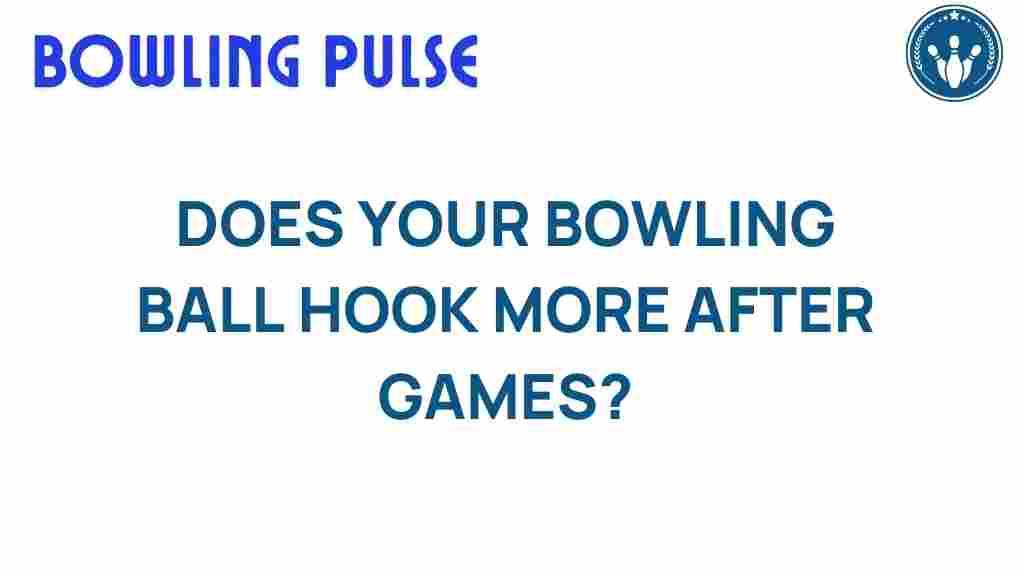The Surprising Truth: Does Your Bowling Ball Hook More After Games?
When it comes to bowling, one of the most critical aspects of performance is how well your bowling ball hooks. Many bowlers, whether amateurs or professionals, often wonder if their bowling ball will perform better in terms of hook after a few games. In this article, we will explore the surprising truth behind this question, delving into the physics of bowling, the effects of technique, and the importance of proper maintenance of your equipment.
Understanding the Physics of Hooking a Bowling Ball
The hook of a bowling ball is primarily influenced by its weight, the surface texture, and the bowler’s technique. When a bowler releases the ball, several forces act upon it, including:
- Friction: The interaction between the ball and the lane surface.
- Rotation: The spin applied by the bowler during the release.
- Gravity: Pulls the ball down the lane.
- Momentum: The speed at which the ball travels affects its hook.
As the bowling ball travels down the lane, it interacts with the oil pattern on the lane, affecting how it hooks. Understanding these forces can help bowlers improve their technique and performance.
Does a Bowling Ball Hook More After Games?
The idea that a bowling ball hooks more after several games may stem from a couple of factors:
- Lane Conditions: After multiple games, the oil pattern on the lane changes. This can either help or hinder the ball’s ability to hook.
- Ball Maintenance: A bowling ball can become more effective if it is properly maintained after several games.
However, it is essential to note that the ball itself does not inherently hook more just because it has been used in multiple games. Instead, the conditions around the ball and the bowler’s technique play a more significant role.
The Importance of Technique
A bowler’s technique significantly influences how much a bowling ball hooks. Here are some techniques to consider:
- Release Point: The moment you release the ball can affect the amount of spin you can impart.
- Grip: The way you grip the ball can influence the rotation. A firmer grip can lead to more hook.
- Follow-Through: A proper follow-through can enhance the ball’s trajectory and hook.
Amateurs often struggle with consistency in these areas, while professionals have perfected their techniques to maximize their bowling ball’s performance. Regular practice and coaching can help improve these skills.
Maintaining Your Bowling Ball for Optimal Performance
Proper maintenance of your bowling ball is crucial for maintaining its performance. Here are some tips:
- Cleaning: Regularly clean your bowling ball after games to remove oil and dirt buildup.
- Resurfacing: Periodically resurface your ball to maintain its texture and improve its grip on the lane.
- Storage: Store your bowling ball in a cool, dry place to prevent warping.
By keeping your bowling ball in good condition, you can ensure that it performs at its best, regardless of whether it has been used in one game or many.
Common Troubleshooting Tips
If you notice that your bowling ball isn’t hooking as much as it used to, consider the following troubleshooting tips:
- Check the Surface: Inspect the surface of your ball for scratches or damage that could affect performance.
- Evaluate Lane Conditions: Be aware of how the oil pattern may have changed over time, affecting your ball’s hook.
- Reassess Your Technique: Sometimes, a change in your personal technique could be influencing your ball’s performance.
If problems persist, it may be time to consult with a professional bowling coach or technician.
When to Consider New Equipment
Over time, every bowler may need to invest in new equipment. Here’s when you should consider upgrading your bowling ball:
- Performance Decline: If your ball consistently underperforms, it may be time for a replacement.
- Change in Style: As your technique improves, you may need a ball that better suits your new style.
- Wear and Tear: If your ball shows significant signs of wear, it may not perform as effectively.
Choosing the right bowling ball is essential for enhancing your game. Research and consult professionals when selecting new equipment.
Conclusion
In conclusion, the performance of your bowling ball—specifically its ability to hook—is influenced by a combination of factors, including lane conditions, the bowler’s technique, and proper maintenance of the equipment. While the bowling ball itself does not inherently hook more after several games, the surrounding circumstances and your approach to bowling can make a significant difference. To enhance your performance, focus on improving your technique, maintaining your equipment, and adapting to changing lane conditions.
For more tips on improving your bowling game, check out this helpful resource. Remember, whether you’re an amateur or a professional, the right knowledge and practice can lead to a more successful bowling experience!
If you’re looking for more insights on bowling techniques or equipment, feel free to explore our other articles here.
This article is in the category Techniques and created by BowlingPulse Team
